The 62-Year-Old Quintessential California Cowgirl
During a life spent in dusty boots and blue jeans, Cindy Rosser has saddled, ridden, roped, shoveled, and seen it all. Writer Andrew Tilin asked her to recount some of her most powerful memories.
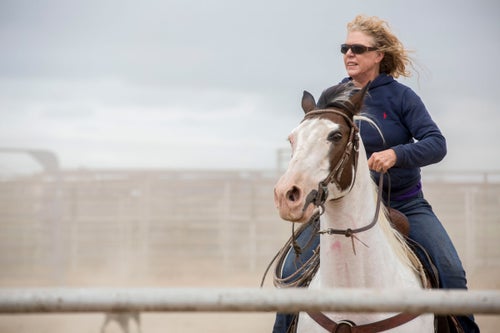
Cindy Rosser, a 62-year-old northern Californian who comes from rodeo royalty and identifies with iconic western figures like Annie Oakley and Florence Hughes Randolph, knows her way around dirt, hooves, and manure. Over many decades spent wearing a cowboy hat, she’s broken her neck in the arena. She’s worked—and worked and worked—for her opportunistic, rodeo-promoting dad, Cotton, who at 89 still shows people why, as the head of the Marysville, California, Flying U Rodeo Company, he’s been dubbed the P.T. Barnum of rodeo. She’s made and lost a few dollars breeding bucking bulls. Late last September, we caught up with Rosser around the ranch and at her hometown event, the 2017 Marysville Stampede.
“Stock contractors can’t get rich. Too much overhead. Too many animals, a lot of feeding, shipping, and fuel. The only rich ones are the folks who have the animals and the oil wells, too,” says Rosser. “I do this because I love this.”
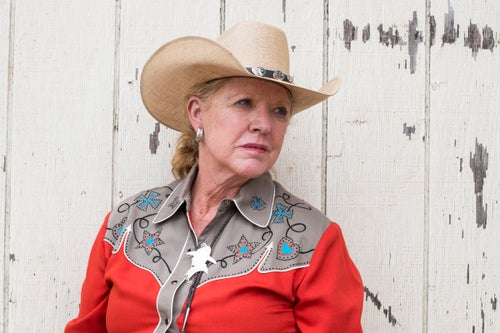
Rosser, all dressed up for the 2017 Marysville Stampede rodeo’s opening act: the ceremonial Twin Cities Cattle Drive. The drive lasts an hour or two, with Rosser and others herding some three dozen roping steers and Texas Longhorn bulls through Yuba City and Marysville.
“In the old days, the women were always the entertainment, the flash and the colorfulness. They were called glamour girls. They trick rode and ran barrels while the guys did their thing,” says Rosser. “About 40 years ago my dad put us in elaborate outfits—rhinestones and embroidery, designed by Nudie Cohn. Nudie made clothes for Roy Rogers. I remember being measured by him. That was interesting.”
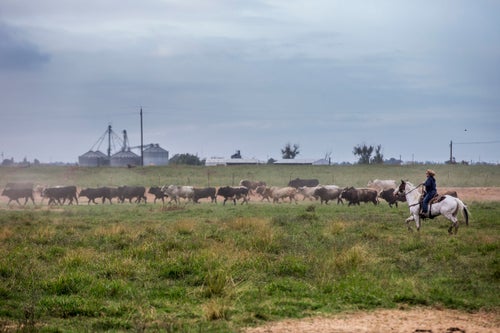
Rosser on her land, where the family’s bulls stay during rodeo season and are regularly gathered and sorted. Rosser’s neighbors include rice farmers and a concrete plant.
“I live on 160 acres. Highway 65 is the four-lane freeway that goes in front of my house. My dad is half a mile away, right there at the off-ramp,” says Rosser. “We were supposed to get a NASCAR track nearby in 2003. We thought development would make our land worth a lot, and that we could then move away from the highway. Didn’t happen.”
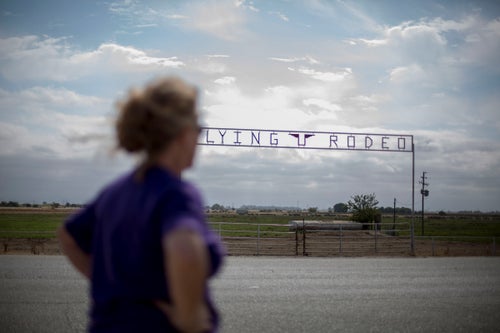
Rosser in front of her father’s property. She lives just next door.
“There are rice farmers around here who have built big, beautiful homes. They’re growing some, but then they get paid not to plant, you know, maybe over there,” says Rosser. “You get paid not to work. I’m in my 60s. Haven’t quite figured that out yet.”
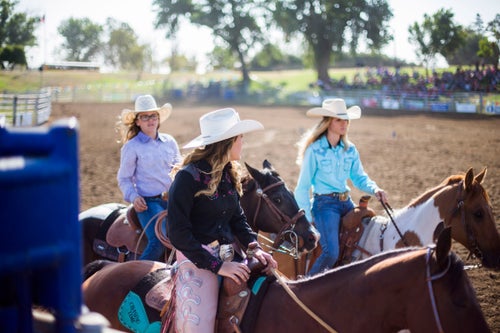
The Stampede’s cattle drive, says Rosser, always attracts locals, like these young women, who want to help in an old western ritual.
“I grew up where I live today. I was still a kid when my mom and dad divorced. She moved back to Red Bluff [California], where her family is from,” says Rosser. “I wanted to be around the horses, and ride. So I stayed, and raised myself. My dad was never around. I left the TV on at night.”
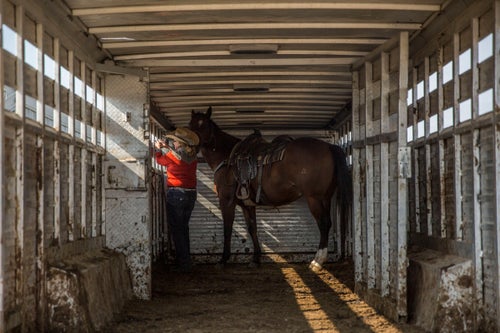
Rosser ties off one of the family’s bay horses, Estell, for transport. She’ll load another nine or so horses into the battered, manure-splattered trailer before it goes anywhere.
“For a while in high school I thought I wanted to go to Montana State. I wanted to get away, blaze my own trail,” says Rosser. “But I really liked working. Up first thing in the morning, doing everything. I loved getting my hands dirty.”
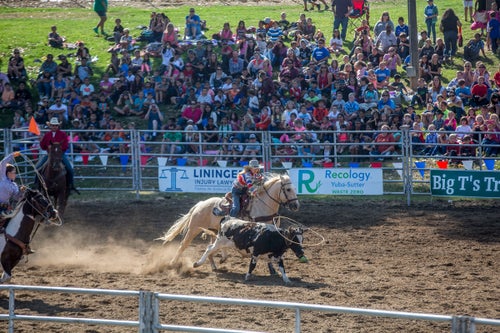
A pair of cowgirls team rope at the Stampede. Rosser says that women rarely compete anymore in bronc or bull riding.
“I remember breaking my neck when I was four or five months pregnant. My barrel-racing horse wasn’t even in the turn, and he slipped. Dumb of me. He’d lost a shoe, and I shouldn’t have run,” says Rosser. “He went end over end, and I drove my head into the dirt. My friend Sandy ran out of the announcer stand and into the arena. I said, it’s my neck. I was put on one of those boards. They taped my head to it. The horse was fine. I broke C1, at the base of the skull. Very few survive and do as well as I did. I’ve been lucky a couple times in wrecks.”
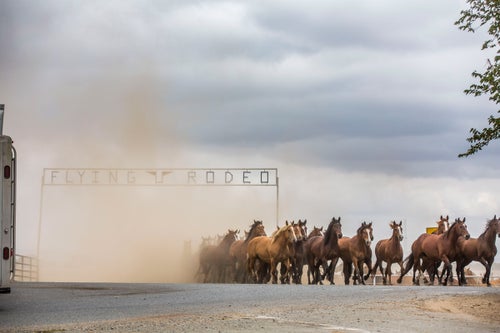
Bucking horses, driven from a nearby pasture and to be sorted ahead of the Stampede, reach Cotton Rosser’s property. They’re headed for a corral.
“Before rodeo started you’d have a get-together and say, let’s get your best cowboy and our best cowboy, and let’s find a bucking bronc for them each to ride. I mean, everybody had at least one outlaw horse on their ranch. It was a game. It was fun. Probably done for money, too,” says Rosser. “With rodeo, now it’s different. We focus a lot of time and resources on raising bucking animals.”
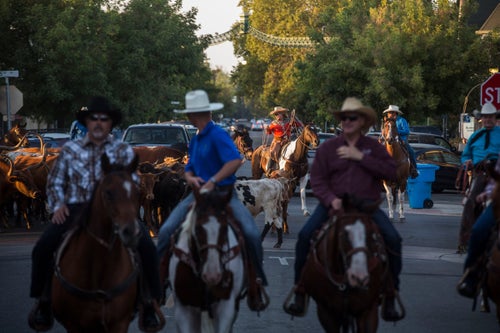
During the Stampede’s cattle drive, Rosser brings up the rear, paying close attention to the livestock. Local dignitaries ride up front, out of potential harm’s way.
“As stock contractors, today people hire us to bring the livestock in, and to run the rodeo for them,” says Rosser. “They’ll take care of the parking and advertising. We put on the rodeo.”
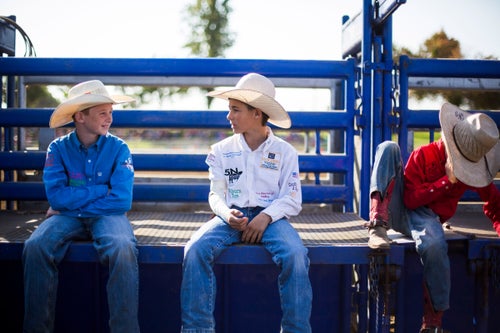
Junior bareback riders, hanging out at the Stampede’s bucking chute and awaiting their turns to ride bucking ponies. The best young athletes have sponsors, travel the U.S. to compete, and get the chance to attend nationals in Las Vegas.
“My son Mikel wasn’t a roper like his father. He loved the bulls. Even when Mikel got sick, he would lay in his hospital bed and study bull bloodlines,” says Rosser. “Mikel’s room is just as it was when he died [Julio Moreno and Rosser’s son, Mikel Moreno, died of leukemia in 2006, at age 18]. I’m a sensitive person. That things bother you? That shows that you loved.”